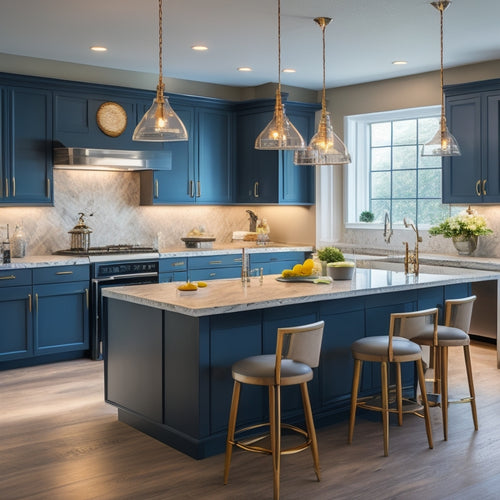
7 Smart Pantry Storage Hacks for Home Cooks
Share
You can turn your pantry chaos into a culinary haven with these 7 smart storage hacks. Start by maximizing vertical space with shelf risers, stacked items, and vertical storage solutions. Employ the back of the door with racks, shelves, and bins to free up shelf space. Label and categorize food items to reduce stress and save time. Implement a "first in, first out" rule to minimize waste, and allocate a spice station area for easy access. Repurpose containers, like mason jars and tea tins, to create functional storage solutions. Finally, develop a pantry inventory system to track staples and streamline shopping trips. By implementing these hacks, you'll be on your way to a more efficient, organized kitchen - and uncover even more opportunities to optimize your pantry.
Key Takeaways
- Maximize vertical space efficiency by using shelf risers, stacking items, and implementing vertical storage solutions to reduce clutter.
- Utilize the back of the pantry door by installing door-mounted racks, adjustable shelves, and over-the-door storage bins for pantry items.
- Label and categorize food items by grouping similar items together, implementing a labeling system, and maintaining a tidy pantry.
- Implement a "first in, first out" rule by storing new items behind older ones, checking expiration dates, and using a "use by" basket.
- Designate a spice station area by allocating a specific shelf or drawer, organizing spices alphabetically or by flavor pairing, and grouping baking spices together.
Maximize Vertical Space Efficiency
How much space are you really utilizing in your pantry? Chances are, you're not making the most of your vertical space.
To maximize your pantry's storage capacity, consider adding shelf risers to create multiple layers of storage. These risers allow you to stack items like cans, jars, and cookbooks, freeing up precious shelf space.
By implementing vertical storage solutions, you can reduce chaos and increase storage efficiency.
Another effective solution is using stackable bins to store dry goods like pasta, rice, and snacks. Label each bin to guarantee easy access to the items you need.
Utilize Back of Door Storage
Now that you've optimized your pantry's vertical space, turn your attention to the often-wasted area on the back of your pantry door. This space is perfect for storing items that are frequently used, but don't require prime shelf real estate.
Install door mounted racks or adjustable shelves to maximize this area. These will provide ample space for spices, oils, or snacks, keeping them organized and within reach.
You can also use over-the-door storage bins or baskets to store items like pasta, rice, or canned goods. By utilizing the back of your pantry door, you'll free up important shelf space and create a more efficient cooking environment.
This hack will help you stay organized and focused, giving you more time to focus on what matters – cooking up a storm!
Label and Categorize Food Items
What's the first thing that comes to mind when you're searching for a specific ingredient in your pantry? Chaos? Frustration? Waste of time?
You can eliminate these feelings by implementing a labeling and categorization system for your food items. This food organization hack is a revolutionary approach for home cooks.
Start by grouping similar items together, such as grains, canned goods, and snacks. Then, label each category and the individual items within it. This will allow you to quickly identify what you have and where it's located.
Item categorization will also help you maintain a tidy pantry and reduce food waste. By taking control of your pantry's organization, you'll save time and reduce stress in the kitchen.
Implement a "First In, First Out" Rule
Implement a "First In, First Out" Rule
Frequently, expired or spoiled food hides in the depths of your pantry, only to be uncovered when it's too late. To avoid this, you need to implement a "first in, first out" rule, ensuring that older items are consumed before newer ones.
This rule helps with expiration tracking and food rotation, ensuring you use the oldest items first.
Here's how to make it work:
- Store new items behind older ones to prevent them from getting buried.
- Check expiration dates when you bring new items home and arrange them accordingly.
- Use a "use by" basket or shelf to keep track of items nearing expiration.
Designate a Spice Station Area
As you reach for a specific spice, you've likely experienced the frustration of digging through a jumbled collection of jars and bottles. To avoid this, designate a spice station area in your pantry.
Choose a convenient location, such as near a countertop or cooking station, and allocate a specific shelf or drawer for your spices. Implement a spice jar organization system, where you store spices alphabetically or by flavor pairing categories.
For instance, group spices commonly used in baking, like cinnamon and nutmeg, together. This thoughtful arrangement will save you time and reduce stress while cooking.
With your spices neatly organized, you'll be more likely to experiment with new flavor pairing tips and recipes.
Repurpose Unconventional Containers
Freedom from cluttered shelves and countertops is within reach when you think outside the box - or in this case, the container.
You can repurpose unconventional containers to create DIY storage solutions that are both functional and space-saving. Get creative with jar upcycling by turning old mason jars into storage containers for dry goods, spices, or even kitchen utensils.
Here are some ideas to get you started:
- Transform old tea tins into mini storage containers for buttons, safety pins, or beads.
- Upcycle cardboard tubes from paper towel rolls or toilet paper rolls into holders for aluminum foil, plastic wrap, or paper bags.
- Reuse old glass vases as storage containers for kitchen utensils, such as wooden spoons, spatulas, or whisks.
Create a Pantry Inventory System
Nearly every pantry has its own unique set of challenges, but one common thread is the need for a reliable inventory system. You need to know what pantry essentials you have, what you're running low on, and what you can get rid of.
Create an inventory checklist to keep track of your pantry staples. Update it every time you shop or use an item. Here's a sample inventory checklist:
| Category | Item | Quantity |
|---|---|---|
| Grains | Rice | 2 bags |
| Canned Goods | Black Beans | 3 cans |
| Baking Supplies | Flour | 1 bag |
Keep your inventory checklist in a visible spot, like on the pantry door or near the shopping list. This way, you can easily check what you need before you head to the store.
Frequently Asked Questions
How Do I Keep Pantry Pests Like Rodents and Insects Away?
Coincidentally, the same night you brought home that fresh loaf, unwanted guests like rodents and insects probably moved in too! You can outsmart them by taking preventive measures like sealing entry points and using natural deterrents like bay leaves and cinnamon sticks.
Can I Store Canned Goods in a Hot Attic or Garage?
You shouldn't store canned goods in a hot attic or garage, as extreme temperatures can affect their quality and safety; instead, choose a cool, dry spot with stable temperatures between 50°F and 70°F for ideal canned goods storage.
Are There Any Food Items I Should Not Store Together?
When storing food, you'll want to separate items that don't play nice together, like onions and potatoes, to maintain food compatibility and preserve flavors.
How Often Should I Clean and Sanitize My Pantry Shelves?
As you savor a freshly baked loaf, dust bunnies multiply in the shadows. Don't let them win! Clean and sanitize your pantry shelves every 1-2 months to prevent pest invasions and spoilage, ensuring a fresh start for your next culinary creation.
Can I Use a Pantry Organizer System in a Small Closet?
You can definitely use a pantry organizer system in a small closet; just measure the space to optimize your pantry layout, and consider adjustable closet shelving to maximize storage and keep everything within easy reach.
Related Posts
-

Garage Storage: A Boost to Your Home Value
Making the Most of a Hidden Gem Are you looking to increase your home's value without breaking the bank? Garage st...
-

7 Kitchen Island Designs With Built-In Seating
You're looking for a kitchen island that not only provides additional counter space and storage but also incorporates...
-

What's Missing in Your Storage Space Solution?
You're likely overlooking hidden opportunities to optimize your kitchen's storage capacity, leading to inefficiencies...


